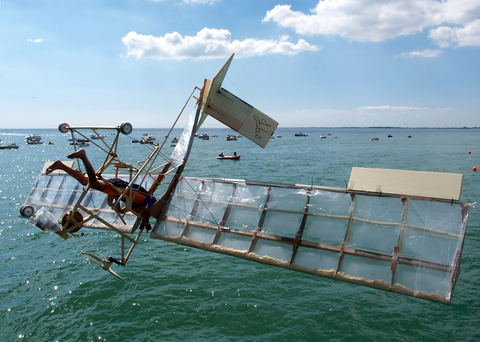Mankind's fancy for flight shows just how fanciful it can get as the second annual Taiwan Birdman Competition takes flight at the Weifeng Canal in Erchung (
At least its participants hope it takes flight. The object of the event is to see who can fly their homemade contraption the furthest by leaping out over the waters of the Weifeng Canal. There are no rules as to what the contraption is, nor whether contestants need to be on top, inside, or strapped underneath it, so long as they pilot it all the way into the water -- an end that's all but guaranteed given the nature of the event.
Designs range from individuals with wings strapped on their backs, to similarly designed bicycles, to more outlandish creations: a bumble bee, a tube of toothpaste and a Mack truck. Pilots wearing capes tend to be a popular theme as well.

PHOTO: AP
"I joined last year's competition as a way to console myself for not passing the tests to become a pilot in Taiwan's Air Force," said one participant named Chen. "I made a cardboard model of Taiwan's IDF aircraft -- the one Chen Shui-bian (
`It Doesn't Fly.' I held it around my waist and jumped into the canal. This year, I'm more serious. I'd like to try and go at least the minimum distance."
Chen's entry this year is a hang glider-like device that he says he's tested by jumping off the roof of his grandmother's house.
The competition is of the same feather as England's annual Bognor Birdman Competition, in which contestants leap off Bognor Regis pier strapped to whatever homemade contraption they've dreamt up for a hoped-for a few seconds of flight and a guaranteed 15 minutes of fame. The Bognor competition regularly attracts tens of thousands of spectators and has gained international media coverage.
First held in 1971, the Bognor event requires that participants fly at least 46m in order to be eligible for prizes, though few of them manage to make it far past the base of the pier.
The Taiwan Birdman Competition sets its sights at an easier -- though still dubious -- 10m. Those who don't have the right stuff for flying are still eligible for several other prizes, including best design, funniest design and biggest splash. As with last year, there will also be a most popular prize voted on by members of the audience.
A second category will see teams jointly piloting crafts, likely for even smaller distances than the individual competitors. Altogther, 67 would-be pilots have entered to test their wings in tomorrow's competition.
Last year's competition didn't really take off -- literally or figuratively. Organizers had expected a large number of spectators, but apparently overestimated the public interest in watching people jump into a canal. They remain undeterred this year, however, and are again hoping to draw a sizable crowd.
"Whether you take it seriously, from the point of view of trying to fly, or think it's just silly, the birdman competition is a lot of fun," said event organizer Wu Mei-ying (
For more information on this year's Taiwan Birdman Competition, check out the event's Web site at www.tw-birdman.org/birdman/index.aspx.

June 23 to June 29 After capturing the walled city of Hsinchu on June 22, 1895, the Japanese hoped to quickly push south and seize control of Taiwan’s entire west coast — but their advance was stalled for more than a month. Not only did local Hakka fighters continue to cause them headaches, resistance forces even attempted to retake the city three times. “We had planned to occupy Anping (Tainan) and Takao (Kaohsiung) as soon as possible, but ever since we took Hsinchu, nearby bandits proclaiming to be ‘righteous people’ (義民) have been destroying train tracks and electrical cables, and gathering in villages

Dr. Y. Tony Yang, Associate Dean of Health Policy and Population Science at George Washington University, argued last week in a piece for the Taipei Times about former president Ma Ying-jeou (馬英九) leading a student delegation to the People’s Republic of China (PRC) that, “The real question is not whether Ma’s visit helps or hurts Taiwan — it is why Taiwan lacks a sophisticated, multi-track approach to one of the most complex geopolitical relationships in the world” (“Ma’s Visit, DPP’s Blind Spot,” June 18, page 8). Yang contends that the Democratic Progressive Party (DPP) has a blind spot: “By treating any

Swooping low over the banks of a Nile River tributary, an aid flight run by retired American military officers released a stream of food-stuffed sacks over a town emptied by fighting in South Sudan, a country wracked by conflict. Last week’s air drop was the latest in a controversial development — private contracting firms led by former US intelligence officers and military veterans delivering aid to some of the world’s deadliest conflict zones, in operations organized with governments that are combatants in the conflicts. The moves are roiling the global aid community, which warns of a more militarized, politicized and profit-seeking trend

This year will go down in the history books. Taiwan faces enormous turmoil and uncertainty in the coming months. Which political parties are in a good position to handle big changes? All of the main parties are beset with challenges. Taking stock, this column examined the Taiwan People’s Party (TPP) (“Huang Kuo-chang’s choking the life out of the TPP,” May 28, page 12), the Democratic Progressive Party (DPP) (“Challenges amid choppy waters for the DPP,” June 14, page 12) and the Chinese Nationalist Party (KMT) (“KMT struggles to seize opportunities as ‘interesting times’ loom,” June 20, page 11). Times like these can